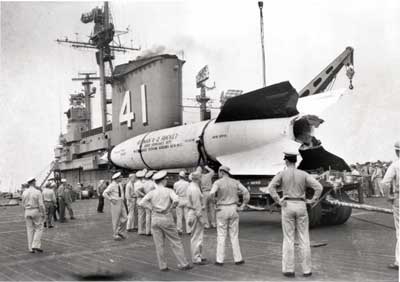USS Midway CV-41

USS Midway museum is in downtown San Diego.
Australians tend to flog off their old aircraft carriers for scrap. Americans turn them into museums. Who is right?
The latest in the ex-USN carrier fleet to join the floating naval aviation museums such as Intrepid in New York, Hornet in San Francisco, Lexington in Corpus Christi and Yorktown in Charleston, is the name ship of the Midway class alongside downtown San Diego. You find this hard to believe? Check out the website http://cv41.org, go to Navy Pier Cam – Choose a View – Midway Museum . There you will see an hourly updated view of the carrier from the roof of a nearby city building.
Too big for Panama Canal
Midway, the first carrier built too large to navigate the Panama Canal, commissioned in 1945, displaced 45,000 tons and was 986 feet (300 metres) long. Importantly, her 12 boilers and 212,000 horsepower turbines drove her at 33 knots, more than fast enough for her three hydraulic catapults to launch her 137 propeller-driven aircraft fully laden, even in no-wind tropical conditions. The first all-steel flight deck in an American aircraft carrier, Midway was built to ride low in the water, to avoid topweight problems. This made her a “wet” ship in any kind of sea.
After two major modernisations, that saw her original open bow enclosed, an angled deck and deck landing sight installed, two steam catapults fitted and other modifications, such as strengthened decks and elevators, she grew to 74,000 tons and 1001 feet (305 metres) long by 1991. Her aircraft complement also changed considerably, proving, once more, a big carrier’s versatility. As the lead ship for nuclear weapons delivery, she launched the first specially converted P2V-3 Neptune by RATOG 5 October 1949. P2V-3s could not be recovered back on board, but Midway proved the concept that the USN could deliver 9,000 lb (4082 kg) nuclear weapons from an aircraft carrier.


Her original propeller-driven aircraft complement evolved over the years to include thoroughbred attack and fighter jets, such as the A-4 Skyhawk, A-6 Intruder, F/A18 Hornet, F-4 Phantom and F-14 Tomcat. Midway also handled the majestic A-5 Vigilante with ease (claims the brochure).
There were three Midway class ships: Midway, Franklin D Roosevelt and Coral Sea. They all stayed in the Atlantic during the late 1940s and early 1950s, along with the big RN fleet carriers, for the “real war” expected any day, while the smaller Essex class and the British light fleet carriers slogged it out in Korea. However, all this changed with Vietnam and later wars. Midway was the first carrier to be based overseas and she homeported in Yokosuka from 1973 for 17 years. She was also the flagship of the Persian Gulf Battle Force Commander in Desert Storm, 1991.
The Naval Aviation Museum at Pensacola promises 40 aircraft to enhance Midway‘s displays. Many were in place when the carrier museum opened for business on 7 June last. This kind of government-supported cooperation is in refreshing contrast with some local policies.

Midway served her country for no less than 47 years until she paid off in 1992. She is much admired. More than 50,000 people visited her in the last three days before being mothballed in Bremerton, WA. Another 23,000 boarded during her first week as a museum in San Diego, and this is in a city of only 1.26 million (in 2002) with many competing attractions.
She is open to visitors daily between 1000 and 1700. Admission charges range from $13 to $7. There is wheelchair access to the flight deck between 1400 and 1600.
